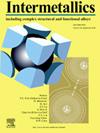Effect of Ti substitution for Co on structural, magnetic, and electronic properties of Co2FeAl Heusler alloy
IF 4.3
2区 材料科学
Q2 CHEMISTRY, PHYSICAL
引用次数: 0
Abstract
In pursuit of materials with high spin polarization, Ti substitution for Co in Co2FeAl was explored to tune the minority spin bandgap near the Fermi level. Consequently, bulk Co2-xFeTixAl (x = 0.00 to 1.00) alloys were synthesized by arc melting followed by heat treatment. Structural analysis showed that the alloys with x = 0.00 and 0.25 exhibited partially disordered B2 structure, while alloys with x ≥ 0.50 exhibited highly ordered L21–type structure. Ab initio calculations revealed an increase in spin polarization from ∼54 % for x = 0.00 to 100 % in x = 0.50 and 0.75, with a transition to semiconducting behavior with zero spin polarization at x = 1.00. The enhanced spin polarization in x = 0.50 and 0.75 was confirmed by analysis of temperature-dependent electrical resistivity data. For the alloys with x = 1.00, resistivity data indicate a metallic character with zero magnetic moment, contrary to the theoretically predicted semiconducting nature, possibly due to a small amount of atomic disorder. With increased Ti substitution, the saturation magnetization decreased from 4.70 ± 0.04 μB/f.u. (for x = 0.00) to ∼0.01 μB/f.u. (for x = 1.00), accompanied by a reduction in the effective magnetic anisotropy constant. The Rhodes-Wohlfarth ratio estimated from thermomagnetization measurements further confirmed the higher spin polarization of alloys with x = 0.50 and 0.75, highlighting their potential for advanced spintronic applications.
求助全文
约1分钟内获得全文
求助全文
来源期刊

Intermetallics
工程技术-材料科学:综合
CiteScore
7.80
自引率
9.10%
发文量
291
审稿时长
37 days
期刊介绍:
This journal is a platform for publishing innovative research and overviews for advancing our understanding of the structure, property, and functionality of complex metallic alloys, including intermetallics, metallic glasses, and high entropy alloys.
The journal reports the science and engineering of metallic materials in the following aspects:
Theories and experiments which address the relationship between property and structure in all length scales.
Physical modeling and numerical simulations which provide a comprehensive understanding of experimental observations.
Stimulated methodologies to characterize the structure and chemistry of materials that correlate the properties.
Technological applications resulting from the understanding of property-structure relationship in materials.
Novel and cutting-edge results warranting rapid communication.
The journal also publishes special issues on selected topics and overviews by invitation only.
 求助内容:
求助内容: 应助结果提醒方式:
应助结果提醒方式:


